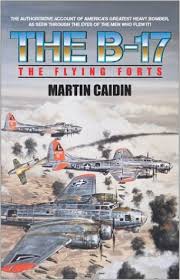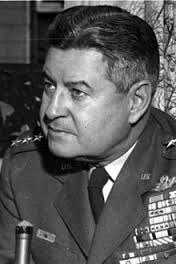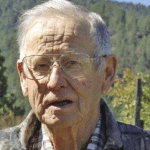Curtis LeMay Once Led Iconic B-17s into European, Pacific Combat
 Writing about the B-17, Martin Caidin chronicles the engineering growth of military aviation after World War I. During the 1930s, Boeing’s gigantic 4-engine bomber outdistanced all competition as the US moved inexorably toward entry into another global war.
Writing about the B-17, Martin Caidin chronicles the engineering growth of military aviation after World War I. During the 1930s, Boeing’s gigantic 4-engine bomber outdistanced all competition as the US moved inexorably toward entry into another global war.
Of course, there was the inevitable resistance of the military status quo—inter-service rivalries and vested ways of doing things—in a world that was dangerously spinning out of control.
Civil engineering graduate Curtis LeMay joined the United States Army Air Corp in 1930 and, by 1937, became a navigator in a B-17 Flying Fortress as it began its first mission of protecting America’s coastlines. By the time of Pearl Harbor, he had already demonstrated the can-do leadership that was sorely needed in battling war machines on several fronts. The B-17 was the strategic weapon of choice in the US arsenal.
Quickly promoted to major, LeMay headed for England in 1942 as commander of the 305th Bomb Group, part of the Eighth Air Force. He remained in the thick of aerial combat, and on August 17, 1943, personally led B-17 units of the 3rd Air Division as commander against the munitions works at Schweinfurt and Regensburg. He then led bombers to North Africa, finally ending up in the Pacific where he commanded the B-29 raids on Tokyo, hoping to decisively end the war through massive firebombing (which later took the two atomic bombs to accomplish).
After the war, LeMay threw all of his leadership energies into the Cold War, beginning with the Berlin Airlift. Later, Robert McNamara singled out LeMay as “the finest combat commander of any service I came across in war,” as described in “Curtis LeMay, a lesson in wartime military leadership.”
 In 1968, General LeMay was chosen to run as the American Independent Party’s vice presidential candidate under George Wallace, but only after GOP candidate Nixon started to look too soft and conciliatory toward the Soviets. After all, Wallace had been the gutsy states rights governor who defiantly stood up to the federal government, forcing the president to nationalize the state’s guard units in the symbolic “Stand in the Schoolhouse Door” incident in 1963.
In 1968, General LeMay was chosen to run as the American Independent Party’s vice presidential candidate under George Wallace, but only after GOP candidate Nixon started to look too soft and conciliatory toward the Soviets. After all, Wallace had been the gutsy states rights governor who defiantly stood up to the federal government, forcing the president to nationalize the state’s guard units in the symbolic “Stand in the Schoolhouse Door” incident in 1963.
 Note: You are invited to hear WW2 USAAF B-17 veteran Maurice Crow of Rapid City on Saturday, December 12, 2015, 9 am at EAFB’s SD Air and Space Museum, an event sponsored by the Black Hills Veterans Writing Group. Crow got credit for 30 missions with the 8th Air Force in Europe. Fellow B-17 crew members from Rapid City Chuck Childs (pilot) and Tom Wenn (ball turret and top gunner) will be there too.
Note: You are invited to hear WW2 USAAF B-17 veteran Maurice Crow of Rapid City on Saturday, December 12, 2015, 9 am at EAFB’s SD Air and Space Museum, an event sponsored by the Black Hills Veterans Writing Group. Crow got credit for 30 missions with the 8th Air Force in Europe. Fellow B-17 crew members from Rapid City Chuck Childs (pilot) and Tom Wenn (ball turret and top gunner) will be there too.
 Writing about the B-17, Martin Caidin chronicles the engineering growth of military aviation after World War I. During the 1930s, Boeing’s gigantic 4-engine bomber outdistanced all competition as the US moved inexorably toward entry into another global war.
Writing about the B-17, Martin Caidin chronicles the engineering growth of military aviation after World War I. During the 1930s, Boeing’s gigantic 4-engine bomber outdistanced all competition as the US moved inexorably toward entry into another global war. In 1968, General LeMay was chosen to run as the American Independent Party’s vice presidential candidate under George Wallace, but only after GOP candidate Nixon started to look too soft and conciliatory toward the Soviets. After all, Wallace had been the gutsy states rights governor who defiantly stood up to the federal government, forcing the president to nationalize the state’s guard units in the symbolic “Stand in the Schoolhouse Door” incident in 1963.
In 1968, General LeMay was chosen to run as the American Independent Party’s vice presidential candidate under George Wallace, but only after GOP candidate Nixon started to look too soft and conciliatory toward the Soviets. After all, Wallace had been the gutsy states rights governor who defiantly stood up to the federal government, forcing the president to nationalize the state’s guard units in the symbolic “Stand in the Schoolhouse Door” incident in 1963. Note: You are invited to hear WW2 USAAF B-17 veteran Maurice Crow of Rapid City on Saturday, December 12, 2015, 9 am at EAFB’s SD Air and Space Museum, an event sponsored by the Black Hills Veterans Writing Group. Crow got credit for 30 missions with the 8th Air Force in Europe. Fellow B-17 crew members from Rapid City Chuck Childs (pilot) and Tom Wenn (ball turret and top gunner) will be there too.
Note: You are invited to hear WW2 USAAF B-17 veteran Maurice Crow of Rapid City on Saturday, December 12, 2015, 9 am at EAFB’s SD Air and Space Museum, an event sponsored by the Black Hills Veterans Writing Group. Crow got credit for 30 missions with the 8th Air Force in Europe. Fellow B-17 crew members from Rapid City Chuck Childs (pilot) and Tom Wenn (ball turret and top gunner) will be there too.